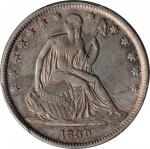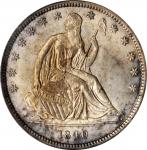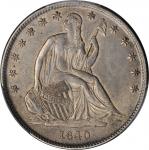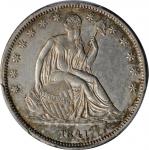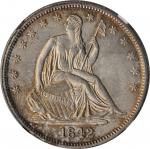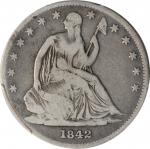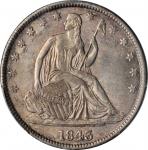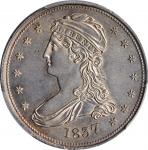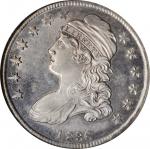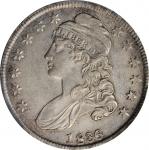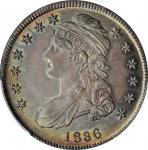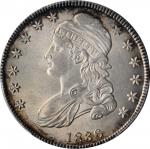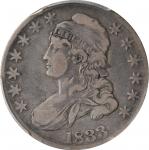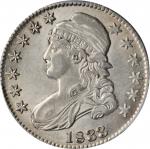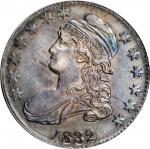1839 Capped Bust Half Dollar. Reeded Edge. HALF DOL. GR-1. Rarity-7. Small Letters. EF-40 (PCGS). CAC.As the single rarest circulation strike Capped Bust, Reeded Edge half dollar, the 1839 Small Letters Reverse enjoys a certain cachet that cannot be rivaled. Specialists in this series eagerly track examples that come on the market and treasure-hunting collectors faithfully turn over each 1839 Capped Bust half dollar they encounter, hoping to spot the telltale pick-up-points for the variety. Only 11 examples were reported as of 2015. This exciting coin, new to the census, brings the census up to 12 possible specimens. It is arguably among the top three in terms of quality and a case could be made that this example is the finest currently available.<p><p><p>Maurice Rosen is credited as the first to identify the 1839 Small Letters as a separate design around September of 1972 and Walter Breen, after studying it closely, recognized that the unusual reverse featured the same eagle hub as the rare 1839-dated Judd-95 pattern, a muling of unrelated dies that was produced by the Mint for collectors in the 1860s. Dick Graham, the author of the standard reference on the Reeded Edge half dollar series, describes the reverse as "smaller and more compact than any eagle on any other variety." The legend is also "smaller and farther from the rim." The easiest characteristic to see by far, however, is the position of the lowest arrow feather in relation to the olive branch: just the tip of the arrow feather is visible below the branch on this reverse, whereas all other reverses show a substantial proportion of the feathers detail below the branchs end.<p>The vast majority of the known coins of this variety suffer from significant damage or heavy wear. The EF-45+ coin certified by PCGS that we offered as lot 4008 in our May 2016 sale of the D. Brent Pogue Collection, Part IV was a notable exception, and the MS-63 example certified by PCGS in 1997 (and unseen by anyone since) would certainly fall into that category, as well. Apart from those two specimens, this EF-40 would be the only other exception to the norm for this variety, and it even shows a significantly sharper strike than the Pogue coin.<p>The obverse surface offers an enticing blend of rose, cobalt and slate gray at the center easing into the fields where sea-green yields to brighter silver gray towards the peripheries. Nearly all star centers are visible apart from that of star 4, with star 3 also showing slight weakness. No marks of any consequence are noted, though three light digs above the date will serve as provenance markers for future research. These take the form of a small horizontal mark above the space between the digits 18, a small vertical mark above the space between the digits 39, and a small horizontal depression above the digit 9 and below the lowest hair curl. Close inspection also reveals minor deposits of adhesive residue at the outside edges of stars 4 and 5, near the border. Raised fields on the obverse (die sinking) are plainly visible and are expected for the variety. A squiggly die line from Libertys temple curl to the eye is also visible and is another expected die marker for the variety. An extremely tiny rim bump to the right of star 9 is also noted after close study with a loupe and serves as an additional identifier for this coin. The rims otherwise are quite strong.<p>On the reverse, the surface is primarily golden-orange with slate gray and cobalt devices. A pair of parallel planchet rolling streaks (as made) extend diagonally from 8 oclock through the word HALF and the bottom corner of the letter D in DOLLAR to the rim at 5:30. These are curiously present on every known example of the variety, on either obverse or reverse. The devices are lightly worn overall and somewhat soft in the central feathers and fletching. The wing feathers, in contrast, are boldly struck. The top of the eagles head is also a bit weak, though the eye is distinct and better defined than on the majority of specimens that we have seen.<p>It is worth delineating the known examples to properly place this present offering in context among the others; this list relying heavily on Dick Grahams work as published in <em>A Registry of Die Varieties of Reeded Edge Half Dollars, 1836-1839</em> (2012), and updated here.<p>1 - <strong>PCGS MS-63</strong><strong>.</strong> Graded in 1997, according to Ron Guth, and listed on the <em>PCGS Population Report</em>. The present owner is unknown and no researcher has been able to confirm its existence.<p>2 - <strong>PCGS EF-45+</strong><strong>.</strong> The Charlton "Swampy" Meyer coin and the discovery specimen for the variety. Discovered by Maurice Rosen in 1972. Ex First Coinvestors, Inc.; Pine Tree Rare Coin Auctions 1973 GENA sale, September 1973, lot 279; unknown intermediary; Julian Leidman; Charlton "Swampy" Meyer Collection, by sale, July 1988; Heritages ANA Signature Auction of July-August 2008, lot 1689; Heritages sale of the Joseph C. Thomas Collection, April 2009 CSNS Signature Auction, lot 2457, via Larry Hanks; our sale of the D. Brent Pogue Collection, Part IV, May 2016, lot 4008; Charles Link Collection<p>3 - <strong>PCGS EF-40. CAC.</strong> <strong><em>The present specimen</em></strong>, and the only one with a CAC approval sticker. Purchased by our consignor in July 1988 from International Coins and Currency of Montpelier, Vermont.<p>4 - <strong>NGC AU-50.</strong> The Greer/Carter coin. Discovered in December 2008. Ex our (Stacks) New York Americana Sale of January 2010, lot 3231; Jim Koenings. Described by Dick Graham as heavily cleaned with hairlines, but possessing the best striking detail of any examples that he had observed.<p>5 - <strong>NCS AU Details--Improperly Cleaned.</strong> The Jules Reiver coin. Discovered by Julian Leidman in Reivers collection circa 1980, which piqued Jules interest in Reeded Edge halves. Ex Heritages sale of the Jules Reiver Collection, January 2006, lot 23442.<p>6 - <strong>PCGS VF-35.</strong> The Mason-Dixon Collection coin. Discovered in March 2004.<p>7 - <strong>PCGS VF-20.</strong> The Southland Collection coin. Ex Julian Leidman; Stanley Scott Collection; our (Bowers and Ruddys) Roy Harte Collection sale, November 1977, lot 2650; Kagins GENA Sale of September 1981, lot 1133; Kagins 333rd Sale, March 1984 sale, lot 1686; Heritages CSNS Signature Auction of May 2007, lot 2131; our (Stacks) Franklinton Collection Part II sale, January 2008, lot 495; our (Stacks) Entlich, White Oak, Gross and St. Andre Collections sale, March 2009, lot 3948.<p>8 - <strong>Very Fine, Cleaned.</strong> A Maryland Collection coin. Auctioned unattributed on eBay in October 2007.<p>9 - <strong>Very Fine, Graffiti.</strong> A Midwest Collection coin. Purchased from Jonathan Kern.<p>10 - <strong>Fine+.</strong> The Walt Bodine Collection coin. Discovered in a Florida coin shop circa 1987. Unseen by Dick Graham. <p>11 - <strong>PCGS Fine Details--Filed Rims.</strong> Ex Heritages Long Beach Signature Auction of June 2015, lot 3964. Possibly the same as #10 above.<p>12 - <strong>PCGS Good-4.</strong> The Merrill Collection coin. Ex Heritages Long Beach Signature Auction of February 2018, lot 3892.<p>Any new 1839 Capped Bust, Small Letters half dollar coming to market would be an event worth remembering, but given the exceptional quality of the present specimen we are especially excited. One of just 12 reported examples, and that number may be too high if the #1 specimen above was a misattribution and #10 and #11 are indeed the same coin. We anticipate strong bidding activity and interest from many different segments of the hobby. Bust half nuts, Reeded Edge half dollar specialists, and <em>Guide Book</em> type collectors will all be bidding for the opportunity to secure this rarity. Only one collector can prevail. Opportunity is knocking!From the E. Horatio Morgan Collection.




